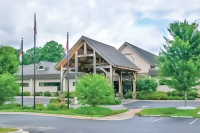Quarry neighbors square off against workers at public hearing
A packed public hearing last week over a Waynesville rock quarry pitted neighbors opposing an expansion of the mine against its workers.
The Allens Creek quarry mines granite, which is used in road building and is the primary raw material in asphalt and concrete. The quarry plays a vital role in the local economy — both as a supplier for the construction industry and provider of jobs, said Todd Quigg, president of Harrison Construction, which operates the quarry.
Quarry supporters wearing crisp, clean ball caps boasting their affiliation with Harrison Construction comprised a large block of the audience.
“Harrison puts food on a lot of people’s tables. We need to do everything we can to support them,” said Walter Moody, a truck driver who hauls rock from the quarry.
Opponents to the quarry expansion outnumbered those speaking in its favor, however. One after another came forward to testify that incessant mica dust is causing respiratory problems in children and old people living nearby.
“It’s not like we want to stop Harrison Construction completely, but we just want to make our lives better so we can breathe,” said Christi Thompson, whose seen a correlation in increased quarry activity and her son’s use of an inhaler and nebulizer.
Related Items
Polly Leatherwood, who likes to drink coffee on her porch in the morning, held up a bag of dust and submitted it as evidence to the hearing officer.
“This is what I have to clean up every morning before I can sit down,” said Leatherwood. “This dust comes down from above. One day it looked like a snowstorm, only it was brown.”
Sherri Inman, the wife of a quarry worker who grew up nearby and still lives there today, had a different story, however.
“I can say with all certainty me nor my family has ever had any health issues due to living one-half mile from the rock quarry,” Inman said. Her dishes have never rattled from the blasting, she isn’t plagued by dust, and her children play outside without breathing problems.
Opponents had been preparing for the hearing for weeks. Their talks were riddled with chapter and verse references to the state statutes that govern quarry permits. A few speakers set up easels to display large photographs documenting dust plumes, silted waterways and even a map showing high incidents of cancer. They directed the audience’s attention to “exhibit A, B or C” as they spoke.
Kenneth Taylor, the head of the N.C. Geological Survey who conducted the hearing, said speakers at public hearings everywhere have grown increasingly savvy in their presentations over the past five years, and the Waynesville crowd was no exception.
“They were ready. They had their game on,” Taylor said.









